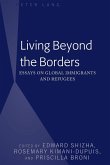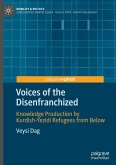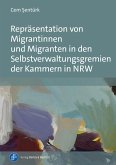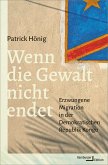Marion Uhle
Marriage Migrants' Way out of Intimate Partner Violence
The Tense Relationship Between the Private and the Public Sphere
Versandkostenfrei innerhalb Deutschlands
54,00 €
inkl. MwSt.
Versandkostenfrei*
Erscheint vorauss. 15. Juni 2026
Melden Sie sich
hier
hier
für den Produktalarm an, um über die Verfügbarkeit des Produkts informiert zu werden.

0 °P sammeln
Marion Uhle
Marriage Migrants' Way out of Intimate Partner Violence
The Tense Relationship Between the Private and the Public Sphere
- Broschiertes Buch
Zwischen Paargewalt und Abschiebung: Wie können Migrant_innen, deren Aufenthaltsstatus von der Ehe abhängt, einen Weg aus häuslicher Gewalt finden? Jede Person, die innerhalb der Partnerschaft Gewalt erlebt, sollte Zugang zu Hilfseinrichtungen erhalten. Für Personengruppen, die durch Heirat in ihr Gastland gekommen sind und Migrationsregelungen unterliegen, ist dieser Zugang jedoch erschwert. Die Studie zeigt, dass in diesen Fällen ein klares Spannungsverhältnis zwischen dem privaten und dem öffentlichen Raum existiert.Auf einer europäischen Perspektive aufbauend, geht die Autorin der Frage…mehr
Andere Kunden interessierten sich auch für
![African Migrants in Africa and Europe African Migrants in Africa and Europe]() Frank Aragbonfoh AbumereAfrican Migrants in Africa and Europe98,99 €
Frank Aragbonfoh AbumereAfrican Migrants in Africa and Europe98,99 €![Living Beyond the Borders Living Beyond the Borders]() Living Beyond the Borders113,20 €
Living Beyond the Borders113,20 €![Voices of the Disenfranchized Voices of the Disenfranchized]() Veysi DagVoices of the Disenfranchized34,99 €
Veysi DagVoices of the Disenfranchized34,99 €![Das Jahrhundert der Flüchtlinge Das Jahrhundert der Flüchtlinge]() Alfons SöllnerDas Jahrhundert der Flüchtlinge19,80 €
Alfons SöllnerDas Jahrhundert der Flüchtlinge19,80 €![Repräsentation von Migrantinnen und Migranten in den Selbstverwaltungsgremien der Kammern in NRW Repräsentation von Migrantinnen und Migranten in den Selbstverwaltungsgremien der Kammern in NRW]() Cem SentürkRepräsentation von Migrantinnen und Migranten in den Selbstverwaltungsgremien der Kammern in NRW34,00 €
Cem SentürkRepräsentation von Migrantinnen und Migranten in den Selbstverwaltungsgremien der Kammern in NRW34,00 €![Den Westen brechen Den Westen brechen]() Alain de BenoistDen Westen brechen32,00 €
Alain de BenoistDen Westen brechen32,00 €![Wenn die Gewalt nicht endet Wenn die Gewalt nicht endet]() Patrick HönigWenn die Gewalt nicht endet40,00 €
Patrick HönigWenn die Gewalt nicht endet40,00 €-
-
-
Zwischen Paargewalt und Abschiebung: Wie können Migrant_innen, deren Aufenthaltsstatus von der Ehe abhängt, einen Weg aus häuslicher Gewalt finden? Jede Person, die innerhalb der Partnerschaft Gewalt erlebt, sollte Zugang zu Hilfseinrichtungen erhalten. Für Personengruppen, die durch Heirat in ihr Gastland gekommen sind und Migrationsregelungen unterliegen, ist dieser Zugang jedoch erschwert. Die Studie zeigt, dass in diesen Fällen ein klares Spannungsverhältnis zwischen dem privaten und dem öffentlichen Raum existiert.Auf einer europäischen Perspektive aufbauend, geht die Autorin der Frage nach, wie dieses Problem die Public Policies in den untersuchten EU-Mitgliedsländern Deutschland, Frankreich und Italien herausfordert, wie zuständige Hilfseinrichtungen mit dieser Problematik umgehen und wie betroffene Personen eigene Strategien finden.
Produktdetails
- Produktdetails
- Schriften der Willy Brandt School of Public Policy an der Universität Erfurt
- Verlag: Budrich Academic Press / Verlag Barbara Budrich
- Artikelnr. des Verlages: 11932
- Seitenzahl: 420
- Erscheinungstermin: 15. Juni 2026
- Englisch
- Abmessung: 210mm x 148mm
- ISBN-13: 9783966650427
- ISBN-10: 3966650428
- Artikelnr.: 63042274
- Herstellerkennzeichnung
- Budrich Academic Press
- Stauffenbergstraße 7
- 51379 Leverkusen
- buch@budrich-unipress.de
- Schriften der Willy Brandt School of Public Policy an der Universität Erfurt
- Verlag: Budrich Academic Press / Verlag Barbara Budrich
- Artikelnr. des Verlages: 11932
- Seitenzahl: 420
- Erscheinungstermin: 15. Juni 2026
- Englisch
- Abmessung: 210mm x 148mm
- ISBN-13: 9783966650427
- ISBN-10: 3966650428
- Artikelnr.: 63042274
- Herstellerkennzeichnung
- Budrich Academic Press
- Stauffenbergstraße 7
- 51379 Leverkusen
- buch@budrich-unipress.de
Marion Uhle is a researcher from Goethe-Universität Frankfurt am Main, Germany, and Université de Strasbourg, France.
INTRODUCTION I. Europe and the context of this research: when the gender issue intimate partner violence meets migration
II. Presentation of the research topic and its scientific interest
III. The state of research - An overview
IV. Definition and contextualization of ambiguous terms
1. Third-country marriage migrants and binational couples
2. A typology of violence
3. Intimate partner violence (IPV)
4. The private and the public sphere
V. Research question and hypotheses VI. Empirical study and methodology
VII. Structure of the thesis
FIRST PART - The issue, theoretic concepts and the context of the present work
Chapter 1 The research question and its context
1.1. Starting with a story
1.2. The construction of the research question
1.3. Contextualization of the research topic
Chapter 2 Mobilized theories and concepts
2.1. Marriage migration
2.1.1. On migration
2.1.2. Female migration
2.1.3. The consideration of marriage migration
2.2. Intersectionality and postcolonial studies
2.3. Who is the Other? What is a victim?
2.4. A blind spot: male victims and female perpetrators
2.5. Gender, power relations and violence
2.6. Intimate partner violence (IPV)
2.7. From the private to the public sphere - Theories of space and their limits with regards to this work
2.8. The lack of a complementary theory focusing on the problem of IPV against third-country marriage migrants whose status depends on their marriage
Chapter 3 Reconnecting the research question and its context
3.1. The International and European context: IPV and marriage migrants
3.2. Object of analysis: the concerned foreign person's way out of IPV and the tense relationship between the private and the public sphere
3.3. National laws and traditions in three European countries as a variable: France, Germany and Italy as a field of research
3.3.1. The choice for France, Germany and Italy
3.3.2. On nationality and citizenship
3.3.3. Migration laws with regards to family reunification
3.3.4. Counteracting IPV: a national norm in line with European and international norms
3.3.5. Facing IPV and migration rules: the hardship case and its limits
3.4. At the interweavement of the private and the public sphere
Chapter 4 Methodology
4.1. Considering available numerical data
4.1.1. European Union: Violence against women, an EU-wide survey (2014)
4.1.2. France: ENVEFF (2000), TeO (2010) and VIRAGE (2017)
4.1.3. Germany: Lebenssituation, Sicherheit und Gesundheit von Frauen in Deutschland. Studie (2004) and its secondary analysis Gesundheit - Gewalt -Migration (2008)
4.1.4. Italy: Indagine multiscopo sulla Sicurezza delle donne (2007/08) and La violenza contro le donne dentro e fuori la famiglia (2015)
4.1.5. A comparative look into numerical data in France, Germany and Italy
4.2. The choice to use a qualitative method
4.3. Interviews
4.3.1. Semi-structured expert interviews
4.3.2. Interviews with concerned persons based on biographical narration
4.4. Ethnographical investigation, observation
4.5. A comparative perspective
4.6. The course of the study
4.6.1. A long-breathed and stony access to the field
4.6.2. Development of the research question, findings and hypothesis generation
4.7. Conditions and handling of the material
4.7.1. The researcher's role
4.7.2. Recording, notes, transcriptions and illustrative material
4.7.3. The question of anonymization
4.7.4. Language
4.7.5. Analysis
SECOND PART - Concerned marriage migrants' experience and its impact
Chapter 1 The types of situations and th
II. Presentation of the research topic and its scientific interest
III. The state of research - An overview
IV. Definition and contextualization of ambiguous terms
1. Third-country marriage migrants and binational couples
2. A typology of violence
3. Intimate partner violence (IPV)
4. The private and the public sphere
V. Research question and hypotheses VI. Empirical study and methodology
VII. Structure of the thesis
FIRST PART - The issue, theoretic concepts and the context of the present work
Chapter 1 The research question and its context
1.1. Starting with a story
1.2. The construction of the research question
1.3. Contextualization of the research topic
Chapter 2 Mobilized theories and concepts
2.1. Marriage migration
2.1.1. On migration
2.1.2. Female migration
2.1.3. The consideration of marriage migration
2.2. Intersectionality and postcolonial studies
2.3. Who is the Other? What is a victim?
2.4. A blind spot: male victims and female perpetrators
2.5. Gender, power relations and violence
2.6. Intimate partner violence (IPV)
2.7. From the private to the public sphere - Theories of space and their limits with regards to this work
2.8. The lack of a complementary theory focusing on the problem of IPV against third-country marriage migrants whose status depends on their marriage
Chapter 3 Reconnecting the research question and its context
3.1. The International and European context: IPV and marriage migrants
3.2. Object of analysis: the concerned foreign person's way out of IPV and the tense relationship between the private and the public sphere
3.3. National laws and traditions in three European countries as a variable: France, Germany and Italy as a field of research
3.3.1. The choice for France, Germany and Italy
3.3.2. On nationality and citizenship
3.3.3. Migration laws with regards to family reunification
3.3.4. Counteracting IPV: a national norm in line with European and international norms
3.3.5. Facing IPV and migration rules: the hardship case and its limits
3.4. At the interweavement of the private and the public sphere
Chapter 4 Methodology
4.1. Considering available numerical data
4.1.1. European Union: Violence against women, an EU-wide survey (2014)
4.1.2. France: ENVEFF (2000), TeO (2010) and VIRAGE (2017)
4.1.3. Germany: Lebenssituation, Sicherheit und Gesundheit von Frauen in Deutschland. Studie (2004) and its secondary analysis Gesundheit - Gewalt -Migration (2008)
4.1.4. Italy: Indagine multiscopo sulla Sicurezza delle donne (2007/08) and La violenza contro le donne dentro e fuori la famiglia (2015)
4.1.5. A comparative look into numerical data in France, Germany and Italy
4.2. The choice to use a qualitative method
4.3. Interviews
4.3.1. Semi-structured expert interviews
4.3.2. Interviews with concerned persons based on biographical narration
4.4. Ethnographical investigation, observation
4.5. A comparative perspective
4.6. The course of the study
4.6.1. A long-breathed and stony access to the field
4.6.2. Development of the research question, findings and hypothesis generation
4.7. Conditions and handling of the material
4.7.1. The researcher's role
4.7.2. Recording, notes, transcriptions and illustrative material
4.7.3. The question of anonymization
4.7.4. Language
4.7.5. Analysis
SECOND PART - Concerned marriage migrants' experience and its impact
Chapter 1 The types of situations and th
INTRODUCTION I. Europe and the context of this research: when the gender issue intimate partner violence meets migration
II. Presentation of the research topic and its scientific interest
III. The state of research - An overview
IV. Definition and contextualization of ambiguous terms
1. Third-country marriage migrants and binational couples
2. A typology of violence
3. Intimate partner violence (IPV)
4. The private and the public sphere
V. Research question and hypotheses VI. Empirical study and methodology
VII. Structure of the thesis
FIRST PART - The issue, theoretic concepts and the context of the present work
Chapter 1 The research question and its context
1.1. Starting with a story
1.2. The construction of the research question
1.3. Contextualization of the research topic
Chapter 2 Mobilized theories and concepts
2.1. Marriage migration
2.1.1. On migration
2.1.2. Female migration
2.1.3. The consideration of marriage migration
2.2. Intersectionality and postcolonial studies
2.3. Who is the Other? What is a victim?
2.4. A blind spot: male victims and female perpetrators
2.5. Gender, power relations and violence
2.6. Intimate partner violence (IPV)
2.7. From the private to the public sphere - Theories of space and their limits with regards to this work
2.8. The lack of a complementary theory focusing on the problem of IPV against third-country marriage migrants whose status depends on their marriage
Chapter 3 Reconnecting the research question and its context
3.1. The International and European context: IPV and marriage migrants
3.2. Object of analysis: the concerned foreign person's way out of IPV and the tense relationship between the private and the public sphere
3.3. National laws and traditions in three European countries as a variable: France, Germany and Italy as a field of research
3.3.1. The choice for France, Germany and Italy
3.3.2. On nationality and citizenship
3.3.3. Migration laws with regards to family reunification
3.3.4. Counteracting IPV: a national norm in line with European and international norms
3.3.5. Facing IPV and migration rules: the hardship case and its limits
3.4. At the interweavement of the private and the public sphere
Chapter 4 Methodology
4.1. Considering available numerical data
4.1.1. European Union: Violence against women, an EU-wide survey (2014)
4.1.2. France: ENVEFF (2000), TeO (2010) and VIRAGE (2017)
4.1.3. Germany: Lebenssituation, Sicherheit und Gesundheit von Frauen in Deutschland. Studie (2004) and its secondary analysis Gesundheit - Gewalt -Migration (2008)
4.1.4. Italy: Indagine multiscopo sulla Sicurezza delle donne (2007/08) and La violenza contro le donne dentro e fuori la famiglia (2015)
4.1.5. A comparative look into numerical data in France, Germany and Italy
4.2. The choice to use a qualitative method
4.3. Interviews
4.3.1. Semi-structured expert interviews
4.3.2. Interviews with concerned persons based on biographical narration
4.4. Ethnographical investigation, observation
4.5. A comparative perspective
4.6. The course of the study
4.6.1. A long-breathed and stony access to the field
4.6.2. Development of the research question, findings and hypothesis generation
4.7. Conditions and handling of the material
4.7.1. The researcher's role
4.7.2. Recording, notes, transcriptions and illustrative material
4.7.3. The question of anonymization
4.7.4. Language
4.7.5. Analysis
SECOND PART - Concerned marriage migrants' experience and its impact
Chapter 1 The types of situations and th
II. Presentation of the research topic and its scientific interest
III. The state of research - An overview
IV. Definition and contextualization of ambiguous terms
1. Third-country marriage migrants and binational couples
2. A typology of violence
3. Intimate partner violence (IPV)
4. The private and the public sphere
V. Research question and hypotheses VI. Empirical study and methodology
VII. Structure of the thesis
FIRST PART - The issue, theoretic concepts and the context of the present work
Chapter 1 The research question and its context
1.1. Starting with a story
1.2. The construction of the research question
1.3. Contextualization of the research topic
Chapter 2 Mobilized theories and concepts
2.1. Marriage migration
2.1.1. On migration
2.1.2. Female migration
2.1.3. The consideration of marriage migration
2.2. Intersectionality and postcolonial studies
2.3. Who is the Other? What is a victim?
2.4. A blind spot: male victims and female perpetrators
2.5. Gender, power relations and violence
2.6. Intimate partner violence (IPV)
2.7. From the private to the public sphere - Theories of space and their limits with regards to this work
2.8. The lack of a complementary theory focusing on the problem of IPV against third-country marriage migrants whose status depends on their marriage
Chapter 3 Reconnecting the research question and its context
3.1. The International and European context: IPV and marriage migrants
3.2. Object of analysis: the concerned foreign person's way out of IPV and the tense relationship between the private and the public sphere
3.3. National laws and traditions in three European countries as a variable: France, Germany and Italy as a field of research
3.3.1. The choice for France, Germany and Italy
3.3.2. On nationality and citizenship
3.3.3. Migration laws with regards to family reunification
3.3.4. Counteracting IPV: a national norm in line with European and international norms
3.3.5. Facing IPV and migration rules: the hardship case and its limits
3.4. At the interweavement of the private and the public sphere
Chapter 4 Methodology
4.1. Considering available numerical data
4.1.1. European Union: Violence against women, an EU-wide survey (2014)
4.1.2. France: ENVEFF (2000), TeO (2010) and VIRAGE (2017)
4.1.3. Germany: Lebenssituation, Sicherheit und Gesundheit von Frauen in Deutschland. Studie (2004) and its secondary analysis Gesundheit - Gewalt -Migration (2008)
4.1.4. Italy: Indagine multiscopo sulla Sicurezza delle donne (2007/08) and La violenza contro le donne dentro e fuori la famiglia (2015)
4.1.5. A comparative look into numerical data in France, Germany and Italy
4.2. The choice to use a qualitative method
4.3. Interviews
4.3.1. Semi-structured expert interviews
4.3.2. Interviews with concerned persons based on biographical narration
4.4. Ethnographical investigation, observation
4.5. A comparative perspective
4.6. The course of the study
4.6.1. A long-breathed and stony access to the field
4.6.2. Development of the research question, findings and hypothesis generation
4.7. Conditions and handling of the material
4.7.1. The researcher's role
4.7.2. Recording, notes, transcriptions and illustrative material
4.7.3. The question of anonymization
4.7.4. Language
4.7.5. Analysis
SECOND PART - Concerned marriage migrants' experience and its impact
Chapter 1 The types of situations and th







